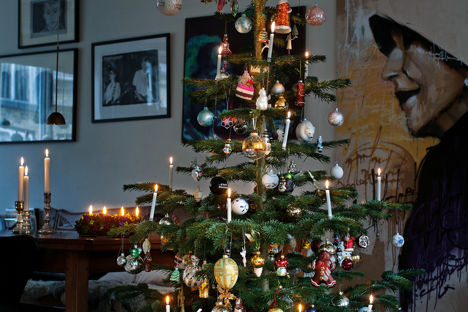
The joy of hygge: a Scandinavian Christmas
Trine Hahnemann sheds some light on the traditions, dishes and festivities celebrated during a typical Danish Christmas.
The joy of hygge: a Scandinavian Christmas
Trine Hahnemann sheds some light on the traditions, dishes and festivities celebrated during a typical Danish Christmas.
Christmas is an important holiday in Scandinavia. We celebrate it differently in each country and eat different dishes. As I have Danish heritage, I stick to a very traditional December celebration. Scandinavian Christmas is not especially religious, but full of fun and lovely food. We do go a little crazy, too! We start celebrating on 1 December by bringing out all our Christmas decorations from storage. It’s a happy time of festivities; families celebrate different traditions of going out to Christmas markets, there are plenty of parties and lunches and we decorate our houses. At the centre of everything is hygge, the Danish term for a special atmosphere – a way to enjoy life in a cozy relaxed way. Christmas, which we call jul, is all about hygge.
On 1 December, I become pathetically happy when I unwrap all the little glass balls, my old antique nisser (pixies), ribbons, candles, stars, and especially my little porcelain snowman. It is actually difficult to explain the sensation of happiness I feel by being reunited with these small, ridiculous and, to some extent, useless items. After I have decorated the whole house I feel, for a short while, that everything is perfect.
Christmas is all about baking, cooking and renewing traditions. On the Sundays of Advent (one of the four Sundays before 25 December), many families celebrate outdoors and play in the snow. Remember, there’s no such thing as bad weather, only wrong clothing. Everyone drinks gløgg (a spiced warm red wine with raisins and almonds), pepperkacker (spiced gingerbread biscuits) and æbleskiver, which are a kind of doughnut served with jam and icing sugar.
From then on, there’s all sorts of cooking to be done in the house, with many different cookies to be baked, chocolate to be tempered, beetroot to be preserved, fish to be cured and terrines to be made – all to be enjoyed from Christmas Eve onwards. And while we do all of that, we also have to get together and enjoy hygge.
We have a very special celebration on 13 December called the Santa Lucia, which is to celebrate food and, therefore, enjoy life. Young girls dress up in white gowns and sing a special song while walking in procession with a lit candle. It’s very moving and beautiful and one of my favourite festive events. We eat Lucia buns, which are soft, sweet saffron treats and drink gløgg again.
The big event
Trine Hahnemann
For the Danish, Christmas Eve is the most important day and the festivities start with dinner at around 6pm. Certainly in my house, dinner is traditionally roasted duck, for which my husband is personally responsible. During the day he will gather with the other men from our neighbourhood and there will be a line of barbecues, where all the birds are roasted together while everyone drinks wine and has a great time.
In addition to duck, we eat roast pork with crispy crackling, sweet and sour red cabbage, caramelised potatoes, gravy and some vegetables like kale, Brussels sprouts and turnips. For dessert, we have a cold rice pudding served with a warm cherry sauce called risalamande. This pudding is to die for – it’s as simple as that. I know lots of Brits who think about school lunch and are put off, but I have actually converted many of my friends in the UK into loving it.
After dinner, we dance around the Christmas tree while singing carols. If you want to understand what this really looks like, I recommend watching Ingmar Bergman’s movie Fanny and Alexander. There you can vividly see how seriously we take the dancing. Afterwards it’s time to open the presents, drink coffee and cognac and eat all the tasty homemade cookies and chocolate made earlier in the month.
After Christmas Eve we still get together for few more celebrations; mostly traditional lunches with friends and family. There we enjoy the smorgasbord with open Danish sandwiches on rye bread. The traditional smorgasbord will start with cured herring, then gravadlax, then warm dishes and cold cuts with lots of different condiments, before ending with cheese and sweets. Foreigners can have a hard time figuring out the rules; they are hidden and unwritten! Many families share a meal like this on Christmas Day, though in our family we usually have it on 26 December with beer and aquavit. I recommend a long walk before lunch to build up an appetite for more delicious food.
Most importantly, Christmas is about enjoying the cosy darkness together and celebrating life. It’s truly perfect if it snows, as then the world becomes twinkling, white and silent.
Photography by Columbus Leth and Lars Ranek.


